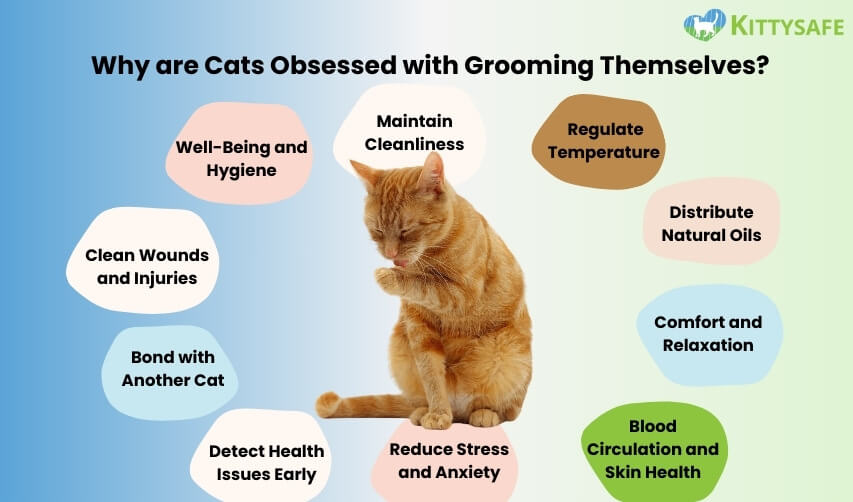Have you ever watched your cat groom themselves and wondered why they do it so? It’s like they can’t get enough of it! While it might seem like just a way to stay clean, there’s a lot more to it than that. Let’s discover some amazing reasons behind your furry friend’s grooming habits!

Cats groom themselves primarily to maintain cleanliness, but this behavior serves multiple essential functions. Grooming helps cat regulate their body temperature and reduce stress; when a cat licks their fur, the saliva evaporates, providing a cooling effect. Also, their rough tongues during grooming distribute natural oils from their skin, keeping their coats smooth and helping protect against dirt and parasites. This instinctual behavior is rooted in their early development, as mother cats groom their kittens to stimulate bodily functions and keep them clean, teaching them the importance of self-grooming from a young age.
Let’s discuss cat grooming in detail and find out why your beloved companions are so dedicated to this behaviour and how you can help them with grooming.
What is Grooming in Cats?
Grooming in cats refers to the act of cleaning themselves by licking their fur with their tongues. It is an instinctual activity performed for a number of reasons, such as keeping the body free from dirt, debris, and loose fur, maintaining healthy skin by spreading natural oils, and regulating body temperature. It plays a crucial role in cat social bonding because the animals groom each other to express affection and trust. It can be soothing, stress-relieving behavior, thus very important to the cat’s health.
There are two types of grooming for cats:
Mutual Grooming:
Mutual grooming refers to the behaviour where two or more cats groom each other. This type of grooming is particularly common in groups of cats that live together in colonies or households. Mutual grooming allows cats to help each other stay clean and remove dirt and parasites from inaccessible areas. In groups of cats, grooming can also play a role in establishing and maintaining social bonds between cats.
Displacement Grooming:
Displacement grooming in cats refers to grooming behaviour that occurs in response to stress, anxiety, or conflict. This behaviour is observed when cats experience loud noises, changes in their environment, or conflicts with other animals.
Are Cats Grooming Themselves Dangerous?
Cats grooming themselves is not generally dangerous; it is a natural and essential behavior for their hygiene and well-being. Cats spend significant time grooming, which helps them control odors, remove dirt, and manage parasites like fleas. Their unique tongues, covered with tiny, hook-like structures, effectively clean their fur and skin while distributing natural oils that maintain coat health. However, excessive grooming can lead to certain issues and indicate underlying health issues, such as allergies or stress, which may require veterinary attention.

Overgrooming, also known as excessive grooming, can be a sign of different health problems and stress associated with cats. When the cat starts grooming themselves, they can remove too much of their protective fur, leading to problems like skin irritation, bald patches, and even skin infections. Overcoming in cats can also cause hairballs and potential gastrointestinal issues due to ingesting too much hair. In certain cases, overgrooming can be a compulsive behaviour, similar to obsessive-compulsive disorder in humans, and may require veterinary intervention to address the underlying cause. It’s important for cat owners to monitor their cat’s grooming habits and consult with a veterinarian if they notice any concerning changes or excessive grooming behavior.
Why Do Cats Lick Themselves?
Cats are self-groomers and often groom themselves for comfort, health, and stress relief.

The six reasons why cats groom themselves are given below:
- Maintain Cleanliness by Removing Dirt and Parasites: Cats are naturally clean animals, although they spend a significant amount of time grooming themselves daily. When they lick their fur, they are basically trying to remove the dust, dirt, and loose hair that accumulates on their bodies throughout the day. These activities of their help them to manage parasites like fleas and ticks, that promotes overall well-being and hygiene.
- Regulate the Temperature Through Saliva Evaporation: To regulate their body temperature through saliva evaporation, cats often groom themselves. When cats lick their fur, saliva is applied to their skin. As the saliva evaporates from the skin, it has a cooling effect on the body. This process helps to maintain their body temperature, especially in summer or when they are overheated.
- Distribute Natural Oils for a Healthy Coat: Grooming plays an important role in maintaining a cat’s healthy coat by distributing the natural oils all over the body. It also helps them to keep their fur clean and free from tangles and hairball formation. These oils also play a crucial role in maintaining the skin’s moisture balance and protecting against dryness and irritation.
- Promote Comfort and Relaxation: Grooming is a key activity for cats that promotes comfort and relaxation. When cats groom themselves, they engage in fun activities that help to reduce stress and anxiety. Moreover, grooming also helps to make cats feel comfortable. By keeping their fur clean, cats can prevent skin irritation and discomfort. It helps to enhance their overall well-being and make them feel comfortable in their environment.
- Detect Health Issues Early: A cat depends on grooming habits as a form of self-examination to detect health issues early. When cats are groomed, they can identify the area in their body with wounds and skin irritations. A change in grooming habits, such as over-grooming or no grooming, can be a sign of underlying health issues. The habit change might indicate discomfort, pain, or illness.
- Bond with Another Cat: Grooming plays an essential role in bonding with another cat by establishing mutual connection and trust. Cats often engage in mutual grooming, known as allogrooming, where they lick and clean each other’s fur. By grooming each other, cats can express their trust and friendship.
- Clean Wounds and Injuries: Cats depend on their grooming habits as a first-aid response to clean wounds and injuries. When a cat gets injured, its immediate reaction is to lick the affected areas. The rough texture of a cat’s tongue helps remove dirt and debris from the wound, reducing the risk of infection. Cat saliva contains enzymes and antibacterial properties that can aid in cleaning the wound and promoting faster healing.
- Stimulate Blood Circulation and Skin Health: Cats engage in regular grooming sessions to stimulate blood circulation and improve skin health. Licking their fur with their rough tongues provides a gentle massage to the skin, which enhances blood flow. The increased blood flow also helps remove toxins and supports the regeneration of skin cells.
Why Do Cats Groom Humans?
When a cat grooms humans, it’s a positive sign of their affection and trust towards humans. Cats groom humans to show affection and bond with their companions.

The five reasons why cats groom humans are:
Affection:
Affection refers to the emotional attachment and kindness cats show to their human companion through grooming. Cats often groom with their human companion just like they groom with other cats to express affection towards their owner. Grooming is a way for cats to demonstrate their feelings of warmth, closeness, and care.
Communication:
A cat licks and grooms its human companion as a form of communication. This helps the cat establish a connection with its human companion, similar to how it bonds with other cats.
Attention:
Attention refers to the focus and care cats give their human companions while grooming. Cats groom and lick humans to get their attention so they can play and interact.
Bonding:
Bonding refers to the emotional connection cats establish with their human companion through grooming. It is a natural bonding behaviour that helps to develop a strong bond between the cat and their fellow human companion.
Marking Territory:
Cats have secant glands on their chin and lips. When cats groom humans, they mark humans with scent to indicate they are part of their family.
Comfort and Security:
Comfort and security refer to the feelings of reassurance and safety that cats may experience or seek when they groom humans. Cats often lick and groom with their human companions to feel comfortable and secure.
What are some Grooming Tips for Cat Owners?

Even if your cat spends most of the time grooming themselves, they might still need your assistance. Grooming your cat is an essential part of companion care. It helps to improve the overall well-being of your fellow companion. It also helps to enhance the bond between you and your companion.
Here are six grooming tips for cat owners to keep their companion healthier and good-looking:
Keep Your Cat Happy with Regular Brushing
Regular brushing of your cat is essential to keep them clean and healthy. Always use a brush that suits your cat’s fur. Brush your cat regularly to remove dirt and loose hair. It also helps them to reduce hair shedding and the formation of hairballs.
Help Your Cat Stay Fresh with Regular Bathing
Cats are natural cleaners and can clean themselves. Baths are not generally necessary for cats to stay clean. Baths are only essential if your cat is dirty or has a skin problem. If you bathe your cat, be sure to use a cat-friendly shampoo. Never use human shampoo, as it can irritate the cat’s skin.
Keep Your Cat’s Claws Neat
Keeping your cat’s claws neat is essential for their health and well-being. Trim your cat’s nails every 1-2 weeks with clippers specially designed for cats. It helps to prevent the overgrowth of nails and reduce scratching damage. You can also use a scratching post or pad to encourage natural claw maintenance and stretching.
Ensure Your Cat’s Health with Proper Dental Care
Proper dental care is essential for maintaining your cat’s health. Regularly brush your cat’s teeth with a cat-specified brush and toothpaste. It helps ensure your cat’s gum and teeth are always clean and healthy. You can also visit veterinary care to monitor your cat’s dental problems.
Ensure Your Cat’s Comfort with Regular Ear Cleaning
Regular ear cleaning is also a part of your cat grooming routine. You should look inside your cat’s ears weekly for signs of dirt, wax, or infection. If anything is found, gently clean it with a cotton ball and cat-safe ear cleaner. Never insert anything deep into your cat’s ears; it could damage their ear drum.
Help Your Cat Manage Stress Effectively
You should always help your cat to manage stress effectively. It is essential for their overall well-being. To help your cat manage stress effectively, create a calm and safe environment at home. Ensure they can access hiding spots, interactive toys, climbing structures, and scratching pads. These activities help them to stay busy and play in a safe environment.
When to get Veterinary Help?
Overgrooming is a serious medical condition and knowing when to seek veterinary help for your cat is essential for addressing the underlying cause. If your cat grooms excessively for over a few days, it is time to get veterinary help to stop your cat from overgrooming.
The 5 signs of your cat indicating veterinary care are:
- If you notice bald patches and signs of infections in your cat.
- Significant changes in your cat’s behaviour, like increased anxiety, aggressive behaviour, and restlessness.
- Loss of weight and poor appetite in your cat.
- Cats indicate symptoms like sneezing, coughing, and diarrhoea, along with over-grooming.
- If over-grooming of your cats lasts more than a few days.
Recommended to Read: What to know about indoor cats?
Maintaining Health and Happiness: Grooming in Enclosures
In conclusion, Cats groom themselves to maintain their fur, skin, and overall hygiene. Understanding why cats groom themselves is essential for cat owners about their furry friend’s overall well-being and behaviors. By creating a safe and secure environment with cat netting enclosures, you can support your furry friend’s natural behavior of grooming themselves and improving their quality of life.
And if you are looking for cat netting enclosures in Perth, we’ve got you covered. At KittySafe, we offer cat enclosures made from top-notch, durable netting that’s pre-stretched and UV-treated, guaranteed for five years! With our side of the house cat enclosures, you can give your kitty a safe outdoor experience while they indulge in their grooming habits and enjoy the fresh air. It’s a win-win for both you and your furry friend!
We create cat netting enclosures that are safe for your cat using high-quality, durable, pre-stretched, UV-treated netting guaranteed for five years.
FAQs
How Often Do Cats Groom Themselves?
Cats typically spend several hours a day grooming themselves. On average, cats may groom themselves for 30% to 50% of their days.
Can Grooming Indicate Health Issues?
Yes, changes in grooming habits can indicate health issues. Excessive grooming might indicate stress, allergies, or skin conditions, while a lack of grooming could suggest dental problems or illness.
Is It Normal for Cats to Groom Each Other?
Yes, changes in grooming habits can indicate health issues. Excessive grooming might indicate stress, allergies, or skin conditions, while a lack of grooming could suggest dental problems or illness.
Should You Let Your Cat Lick You?
Yes, you should let your cat lick you. This is generally a common behaviour between cats and their owners. Cats lick their owner’s hands and arms as a sign of affection. But avoid licking your face, as a cat’s tongue is full of bacteria if your immune system is weak.
How Do I Know If My Cat Is Stressed?
If your cats are stressed, you may notice a change in their normal behaviour, body language, and routine. They may start acting aggressively, lose weight due to a low appetite, or over-groom.





